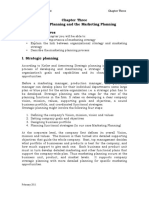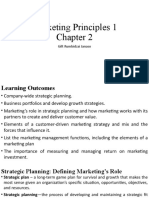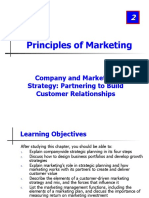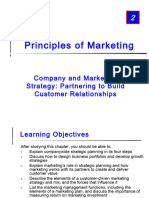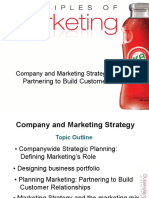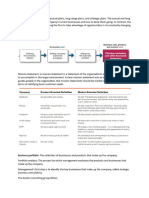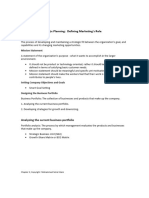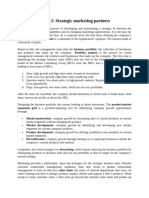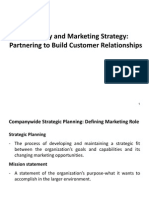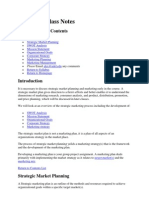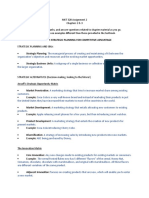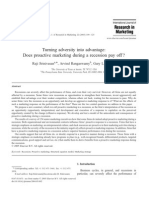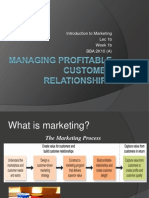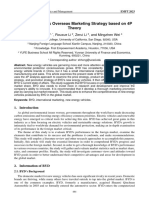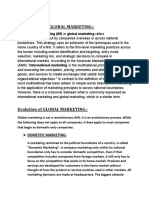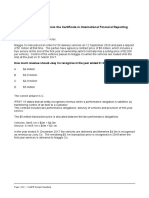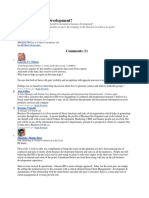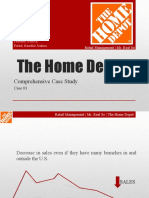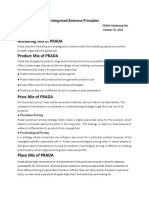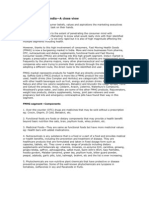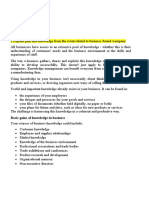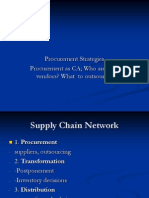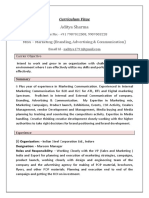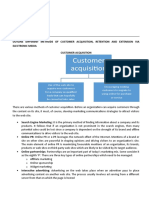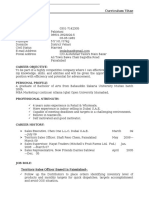Lecture 2a Week 2a BBA 2K10 (A)
Lecture 2a Week 2a BBA 2K10 (A)
Uploaded by
Alina KhanCopyright:
Available Formats
Lecture 2a Week 2a BBA 2K10 (A)
Lecture 2a Week 2a BBA 2K10 (A)
Uploaded by
Alina KhanOriginal Description:
Original Title
Copyright
Available Formats
Share this document
Did you find this document useful?
Is this content inappropriate?
Copyright:
Available Formats
Lecture 2a Week 2a BBA 2K10 (A)
Lecture 2a Week 2a BBA 2K10 (A)
Uploaded by
Alina KhanCopyright:
Available Formats
Lecture 2a Week 2a BBA 2K10 (A)
Class Today!!!
Companywide strategic planning in its four steps
Market oriented mission statement
Company objectives and goals How to design business portfolios and develop growth strategies; BCG Matrix and Expansion Grid
Companywide Strategic Planning:
Defining Marketings Role
Strategic Planning Strategic planning is the process of developing and maintaining a strategic fit between the organizations goals and capabilities and its changing marketing opportunities
Companywide Strategic Planning: Defining Marketings Role
Strategic Planning Purpose: To find ways in which the company can best use its strengths to take advantage of attractive opportunities in the environment
Companywide Strategic Planning:
Defining Marketings Role
Steps in the Strategic Planning Process
Companywide Strategic Planning: Defining Marketings Role
Defining a Market-Oriented Mission
The mission statement is the organizations purpose, what it wants to accomplish in the larger environment
Market-oriented mission statement defines the business in terms of satisfying basic customer needs
The Mission Statement
Questions the mission statement should answer include:
What is our business? Who is our customer? What do consumers value? What should our business be?
Mission statements should be market oriented, not product oriented.
The Mission Statement
Should be realistic Should be specific Should fit the market environment Should be based on distinctive competencies Should be motivating
Market-Oriented Business Definitions
Companywide Strategic Planning: Defining Marketings Role
Setting Company Objectives and Goals
Business objectives Marketing objectives
Setting Firm Objectives and Goals
The mission should be translated into supporting objectives for each level of management.
Creates a hierarchy of objectives that are
consistent with one another. For example:
Business objective: Increase profits. Marketing objective: Increase market share of
domestic and international markets.
Companywide Strategic Planning:
Defining Marketings Role
Designing the Business Portfolio The business portfolio is the collection of businesses and products that make up the company
Companywide Strategic Planning:
Defining Marketings Role
Analyzing the Current Business Portfolio Analyzing the business portfolio is the process by which management evaluates the products and businesses making up the company
Companywide Strategic Planning:
Defining Marketings Role Analyzing the Current Business Portfolio
1.
2. 3.
Identify key businesses (strategic business units, or SBUs) that make up the company Assess the attractiveness of its various SBUs Decide how much support each SBU deserves
Companywide Strategic Planning:
Defining Marketings Role Analyzing the Current Business Portfolio Strategic business unit (SBU) is a unit of the company that has a separate mission and objectives that can be planned separately from other company businesses Company division Product line within a division Single product or brand
Companywide Strategic Planning:
Defining Marketings Role
Analyzing the Current Business Portfolio Assess the attractiveness of its various SBUs and decide how much support each deserves in terms of:
Industry attractiveness Strength of the SBUs position in the market or industry
Companywide Strategic Planning:
Defining Marketings Role
Analyzing the Current Business Portfolio
The Boston Group Approach (BCG Matrix)
Growth share matrix is a portfolio-planning method that evaluates a companys SBUs in terms of their market growth rate and relative share.
Companywide Strategic Planning:
Defining Marketings Role Analyzing the Current Business Portfolio
The Boston Group Approach
SBUs are classified as:
Stars
Cash cows Question marks
Dogs
Companywide Strategic Planning:
Defining Marketings Role Analyzing the Current Business Portfolio
The Boston Group Approach
Stars are high-growth, high-share businesses or products requiring heavy investment to finance rapid growth. They will eventually turn into cash cows. Cash cows are low-growth, high-share businesses or products that are established and successful SBUs requiring less investment to maintain market share
Companywide Strategic Planning:
Defining Marketings Role
Analyzing the Current Business Portfolio
The Boston Group Approach Question marks are low-share business units in high-growth markets requiring a lot of cash to hold their share Dogs are low-growth, low-share businesses and products that may generate enough cash to maintain themselves but do not promise to be large sources of cash
Companywide Strategic Planning:
Defining Marketings Role
Companywide Strategic Planning:
Defining Marketings Role Developing Strategies for Growth and Downsizing
Product/market expansion grid is a tool for identifying company growth opportunities through market penetration, market development, product development, or diversification
Companywide Strategic Planning:
Defining Marketings Role
Developing Strategies for Growth and Downsizing
Product Market Expansion Grid
Market Penetration: Making more sales to
current customers without changing its product.
Market Development:
Identifying and developing new markets for its current products.
Product Development: Offering modified
or new products to current markets.
Diversification: Starting up or buying
businesses outside its current products and markets
Companywide Strategic Planning: Defining Marketings Role
Developing Strategies for Growth and Downsizing
Downsizing is the reduction of the business portfolio by eliminating products or business units that are not profitable or that no longer fit the companys overall strategy
You might also like
- DM MICA 65 Pragya Chandra Mamaearth SubmissionDocument15 pagesDM MICA 65 Pragya Chandra Mamaearth Submissionpr amateurNo ratings yet
- ICC International Code On SponsorshipDocument7 pagesICC International Code On Sponsorshipshuvro25No ratings yet
- Strategic Brand Plan For TwinkieDocument14 pagesStrategic Brand Plan For TwinkieNicole Wetzell100% (1)
- Chapter 2 UpdatedDocument10 pagesChapter 2 Updatedi211416 Shizza KianiNo ratings yet
- Session 2 Understanding Marketing and The Market ProcessDocument31 pagesSession 2 Understanding Marketing and The Market ProcessJERRALYN ALVANo ratings yet
- Marketing & Company Strategy: Course: MKT 202 Lecturer: Emran Mohammad (Emd)Document17 pagesMarketing & Company Strategy: Course: MKT 202 Lecturer: Emran Mohammad (Emd)masvood0% (1)
- Principles of Marketing (Chapter 2)Document28 pagesPrinciples of Marketing (Chapter 2)Salman Preeom100% (5)
- Module PrinciplesOfMarketing Chapter2 120304Document9 pagesModule PrinciplesOfMarketing Chapter2 120304Kaye PauleNo ratings yet
- Marketing Chapter 3Document8 pagesMarketing Chapter 3FuadNo ratings yet
- Company Wide Strategic PlanningDocument8 pagesCompany Wide Strategic Planningogenrwotronald10No ratings yet
- Developing Marketing Strategies & Plans: Company and Marketing Strategy: Partnering To Build Customer RelationshipsDocument38 pagesDeveloping Marketing Strategies & Plans: Company and Marketing Strategy: Partnering To Build Customer RelationshipsMarisol DulceNo ratings yet
- Strategic Planning and The Marketing ProcessDocument19 pagesStrategic Planning and The Marketing ProcessDr Rushen SinghNo ratings yet
- Chapter-4 (Company and Marketing Strategy (Partnering To Build Customer Relationships)Document39 pagesChapter-4 (Company and Marketing Strategy (Partnering To Build Customer Relationships)Hein KhantNo ratings yet
- Week 2 Handout PDFDocument15 pagesWeek 2 Handout PDFkiks fernsNo ratings yet
- Chapter 2 Marketing StrategyDocument36 pagesChapter 2 Marketing StrategyChill Christ Villanueva HernandezNo ratings yet
- Chapter 2 SummaryDocument3 pagesChapter 2 SummaryeudamnboredNo ratings yet
- Marketing For Engineers CH 2Document80 pagesMarketing For Engineers CH 2karim kobeissiNo ratings yet
- Company and Marketing Strategy, Partnering To Build Customer RelationshipsDocument62 pagesCompany and Marketing Strategy, Partnering To Build Customer RelationshipsEunice Ajonan Ubante100% (2)
- Marketing Management - BA3602: Nabeel Farooq Nabeel - Farooq@szabist-Isb - Edu.pkDocument46 pagesMarketing Management - BA3602: Nabeel Farooq Nabeel - Farooq@szabist-Isb - Edu.pkSaad MazherNo ratings yet
- Strategic Planning: The Process of Developing and MaintainingDocument35 pagesStrategic Planning: The Process of Developing and MaintainingMaliha TribhuNo ratings yet
- Chapter 2 Company and Marketing StrategyDocument42 pagesChapter 2 Company and Marketing StrategyGenoso OtakuNo ratings yet
- Priciples of Marketing by Philip Kotler and Gary ArmstrongDocument36 pagesPriciples of Marketing by Philip Kotler and Gary Armstrongazee inmixNo ratings yet
- Chapter#2: Company and Marketing Strategy Partnering To Build Customer RelationshipsDocument35 pagesChapter#2: Company and Marketing Strategy Partnering To Build Customer RelationshipsZahid IslamNo ratings yet
- Marketing Management - Module 2Document20 pagesMarketing Management - Module 2Genner RazNo ratings yet
- Principles of Marketing 1 Chapter 2Document72 pagesPrinciples of Marketing 1 Chapter 2Tinotenda FredNo ratings yet
- MKT Lecture 2Document17 pagesMKT Lecture 2Sopnil AkashNo ratings yet
- Strategic Planning and The Marketing ProcessDocument54 pagesStrategic Planning and The Marketing ProcesslesllyeNo ratings yet
- Principles of Marketing: Company and Marketing Strategy: Partnering To Build Customer RelationshipsDocument58 pagesPrinciples of Marketing: Company and Marketing Strategy: Partnering To Build Customer RelationshipsAbdul WahabNo ratings yet
- Principles of Marketing: Company and Marketing Strategy: Partnering To Build Customer RelationshipsDocument49 pagesPrinciples of Marketing: Company and Marketing Strategy: Partnering To Build Customer RelationshipsTim IchigoNo ratings yet
- Unit 2 MMDocument34 pagesUnit 2 MMmonishajai8336No ratings yet
- Chapter 02Document45 pagesChapter 02Dr. Muhammad Khalid IqbalNo ratings yet
- Marketing Chapter 3Document38 pagesMarketing Chapter 3osama ahmedNo ratings yet
- Principle of MarketingDocument3 pagesPrinciple of MarketingTuan AnhNo ratings yet
- Strategic Planning and Marketing ProcessDocument42 pagesStrategic Planning and Marketing ProcessGaurav gusaiNo ratings yet
- Chapter 2 MKTDocument3 pagesChapter 2 MKTMohammad Mahibur RahmanNo ratings yet
- Strategic Planning - The Process of Developing and Maintaining A Strategic Fit Between The Organization'sDocument17 pagesStrategic Planning - The Process of Developing and Maintaining A Strategic Fit Between The Organization'shana hansNo ratings yet
- FHBM1124 Marketing Chapter 2-Strategic Planning 1 .PPT VijDocument46 pagesFHBM1124 Marketing Chapter 2-Strategic Planning 1 .PPT VijGerrich TeohNo ratings yet
- Chapter 2Document37 pagesChapter 2aamirkanNo ratings yet
- BMKT300 - Chapter 2Document43 pagesBMKT300 - Chapter 2KassemNo ratings yet
- Market Oriented Strategic Planning: Chapter-02Document16 pagesMarket Oriented Strategic Planning: Chapter-02Sharif HossinNo ratings yet
- 2-3 Strategic Marketing PartnersDocument2 pages2-3 Strategic Marketing PartnersSumair S.No ratings yet
- Branding Strategy Learning UnitDocument100 pagesBranding Strategy Learning UnitethancfisherNo ratings yet
- Company and Marketing StrategyDocument10 pagesCompany and Marketing StrategynayeemNo ratings yet
- Marketing Strategy: Company andDocument33 pagesMarketing Strategy: Company andeptiNo ratings yet
- MARKETINGDocument37 pagesMARKETINGHASEEB SULMANNo ratings yet
- Chapter 2 Class NotesDocument6 pagesChapter 2 Class NotesSatadru SenguptaNo ratings yet
- Chapter FiveDocument9 pagesChapter FiveNathnael SemunegusNo ratings yet
- CHAPTER 2 Market Oriented Strategic MarketingDocument39 pagesCHAPTER 2 Market Oriented Strategic MarketingainnurjannahNo ratings yet
- CH 2Document17 pagesCH 2hesham hassanNo ratings yet
- Chapter 2 - Strategic Marketing PartnersDocument68 pagesChapter 2 - Strategic Marketing PartnersJeremiah PlatinoNo ratings yet
- Question No. 1: A. Define MarketingDocument9 pagesQuestion No. 1: A. Define MarketingNipuNo ratings yet
- For PresentationDocument46 pagesFor PresentationJaninelaraNo ratings yet
- ppt2 Marketing ManagementDocument45 pagesppt2 Marketing ManagementRahayu BfNo ratings yet
- Designing The Business PortfolioDocument4 pagesDesigning The Business PortfolioAzael May PenaroyoNo ratings yet
- Chapter 2: Strategic Planning For Competitive AdvantageDocument7 pagesChapter 2: Strategic Planning For Competitive AdvantageSavannah StormhammerNo ratings yet
- Marketing Management - MT2 - Chapter 2 - Developing Marketing Strategies and PlansDocument51 pagesMarketing Management - MT2 - Chapter 2 - Developing Marketing Strategies and Plansrkhan162054No ratings yet
- CH 5 - 210221121818Document10 pagesCH 5 - 210221121818Dawit WenduNo ratings yet
- Chapter # 2Document25 pagesChapter # 2khurram shahzadNo ratings yet
- Company and Marketing Strategy: Partnering To Build Customer RelationshipsDocument48 pagesCompany and Marketing Strategy: Partnering To Build Customer Relationshipsazwan ayop0% (1)
- Chapter 2 - Company & Marketing Strategy (PART 1)Document38 pagesChapter 2 - Company & Marketing Strategy (PART 1)Abdul GhaniNo ratings yet
- Module 3 - Company AnalysisDocument15 pagesModule 3 - Company AnalysisMer VelasquezNo ratings yet
- How to Write a Business Plan: A Step-by-Step Guide for EntrepreneursFrom EverandHow to Write a Business Plan: A Step-by-Step Guide for EntrepreneursNo ratings yet
- An Introduction To Cost Terms and PurposesDocument18 pagesAn Introduction To Cost Terms and PurposesAlina KhanNo ratings yet
- Lecture 2b Week 2b BBA 2K10 (A)Document35 pagesLecture 2b Week 2b BBA 2K10 (A)Alina KhanNo ratings yet
- POM Project Deadline: S.No Deliverables Dead LineDocument1 pagePOM Project Deadline: S.No Deliverables Dead LineAlina KhanNo ratings yet
- POM Lecture 9 BBA 2K10 (A)Document25 pagesPOM Lecture 9 BBA 2K10 (A)Alina KhanNo ratings yet
- Principles of Marketing Syllabus For Final Exams BBA 2K10 (A)Document1 pagePrinciples of Marketing Syllabus For Final Exams BBA 2K10 (A)Alina KhanNo ratings yet
- Pom Bba 2K10 (A)Document34 pagesPom Bba 2K10 (A)Alina KhanNo ratings yet
- Phase I:: Ms. Fatima.Z.Nasir Fatima@nbs - Edu.pkDocument2 pagesPhase I:: Ms. Fatima.Z.Nasir Fatima@nbs - Edu.pkAlina KhanNo ratings yet
- POM Lecture 7-A BBA 2K10Document32 pagesPOM Lecture 7-A BBA 2K10Alina KhanNo ratings yet
- Lecture 6-c POM BBA 2K10Document30 pagesLecture 6-c POM BBA 2K10Alina KhanNo ratings yet
- POM Lecture 7-b BBA 2K10-ADocument27 pagesPOM Lecture 7-b BBA 2K10-AAlina KhanNo ratings yet
- Lecture 6-b Pom Bba 2K10Document20 pagesLecture 6-b Pom Bba 2K10Alina KhanNo ratings yet
- Turning Adversity Into Advantage: Does Proactive Marketing During A Recession Pay Off ?Document17 pagesTurning Adversity Into Advantage: Does Proactive Marketing During A Recession Pay Off ?Alina KhanNo ratings yet
- Introduction To Marketing Lec 1b Week 1b BBA 2K10 (A)Document18 pagesIntroduction To Marketing Lec 1b Week 1b BBA 2K10 (A)Alina KhanNo ratings yet
- Global Organizations - An AnalysisDocument10 pagesGlobal Organizations - An AnalysisAlina KhanNo ratings yet
- Finanical ManagementDocument589 pagesFinanical Managementsnarramneni81% (21)
- Efficient MArket Hypothesis and ForecastingDocument13 pagesEfficient MArket Hypothesis and ForecastingDalia Hussniey AqeelNo ratings yet
- Limit and Exponential Functions: The Above Graph Confirm That Exponential Functions Are Continuous EverywhereDocument24 pagesLimit and Exponential Functions: The Above Graph Confirm That Exponential Functions Are Continuous EverywhereAlina KhanNo ratings yet
- Sohail Tariq Presentation Pizza Hut PromotionDocument11 pagesSohail Tariq Presentation Pizza Hut PromotionSOHAIL TARIQNo ratings yet
- CASAS BAHIA-Marketing To The PoorDocument8 pagesCASAS BAHIA-Marketing To The PoorAshley VargheseNo ratings yet
- Reshape - Business PlanDocument28 pagesReshape - Business Plansophia abantoNo ratings yet
- Summer Training Report On Social Media Marketing: (BCOM-309)Document22 pagesSummer Training Report On Social Media Marketing: (BCOM-309)Vikrant Nain80% (5)
- IspravaDocument28 pagesIspravaAkshay PopawalaNo ratings yet
- Chapter 1 Defining Marketing For The 21st CenturyDocument14 pagesChapter 1 Defining Marketing For The 21st Centurymaryayume.koduNo ratings yet
- Emft2023 484 490Document7 pagesEmft2023 484 490jjjane0825No ratings yet
- Introduction To Global MarketingDocument3 pagesIntroduction To Global Marketingpavann231No ratings yet
- Digital Marketing For Dummies Katie William PHDDocument12 pagesDigital Marketing For Dummies Katie William PHDadelineo vlog ONo ratings yet
- New Smartphone Launch Marketing Plan by SlidesgoDocument41 pagesNew Smartphone Launch Marketing Plan by SlidesgoMauricio GarbozaNo ratings yet
- Wish Return Policy Phone NumberDocument2 pagesWish Return Policy Phone NumberWish Help CenterNo ratings yet
- 7.4 Monopoly - Market Outcomes, Efficiency and EvaluationDocument14 pages7.4 Monopoly - Market Outcomes, Efficiency and EvaluationSimna Sarah StephenNo ratings yet
- Reporting Group 4 BSHM 75 2Document29 pagesReporting Group 4 BSHM 75 2viaalaizamNo ratings yet
- Speed/ Processing Time of Different Journals in Management/Inter Business/ Marketing As On March 2017 (Will Be Updated Time To Time)Document4 pagesSpeed/ Processing Time of Different Journals in Management/Inter Business/ Marketing As On March 2017 (Will Be Updated Time To Time)manishaamba7547No ratings yet
- Two Example Questions From The Certificate in International Financial Reporting (Certifr) AssessmentDocument2 pagesTwo Example Questions From The Certificate in International Financial Reporting (Certifr) AssessmentAbirami AbiNo ratings yet
- What Is Business DevelopmentDocument3 pagesWhat Is Business DevelopmentlaasantosNo ratings yet
- The Home Depot: Comprehensive Case StudyDocument14 pagesThe Home Depot: Comprehensive Case Studyjer_operioNo ratings yet
- Class 12 Marketing Case StudiesDocument3 pagesClass 12 Marketing Case Studieslalitakanojia2008No ratings yet
- PRADA Marketing Mix (CARCASONA)Document2 pagesPRADA Marketing Mix (CARCASONA)Kylle JoelNo ratings yet
- FMHG Market in IndiaDocument5 pagesFMHG Market in IndiaNitin SrivastavaNo ratings yet
- Anindita Chaki 17SMAS102029 B. Pharm, 8 Sem Lmr-Ii AssignmentDocument3 pagesAnindita Chaki 17SMAS102029 B. Pharm, 8 Sem Lmr-Ii AssignmentAnindita ChakiNo ratings yet
- Session IX, X Supply Chain ProcurementDocument33 pagesSession IX, X Supply Chain ProcurementAbhik DattaNo ratings yet
- Aditya Sharma) : MBA - Marketing (Branding, Advertising & CommunicationDocument3 pagesAditya Sharma) : MBA - Marketing (Branding, Advertising & CommunicationKanupriya JainNo ratings yet
- Pricing Strategies For Each Stage of PLCDocument9 pagesPricing Strategies For Each Stage of PLCYedhu KNo ratings yet
- 302 - Abhilasha Singh - Learning Diary 8Document3 pages302 - Abhilasha Singh - Learning Diary 8Abhilasha SinghNo ratings yet
- Reading List 2020/21: Certificate in Professional Marketing Certificate in Professional Digital MarketingDocument12 pagesReading List 2020/21: Certificate in Professional Marketing Certificate in Professional Digital MarketingInes Benvenutta KhoziNo ratings yet
- Imdad Ali: Career ObjectiveDocument3 pagesImdad Ali: Career ObjectiveMuhammad ZeeshanNo ratings yet








